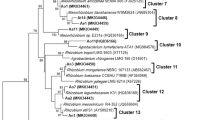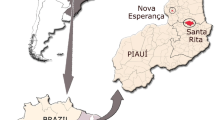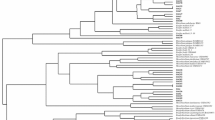Abstract
Fifty-five bacterial isolates were obtained from surface-sterilized nodules of woody and shrub legumes growing in Ethiopia: Crotalaria spp., Indigofera spp., and Erythrina brucei, and the food legumes soybean and common bean. Based on partial 16S rRNA gene sequence analysis, the majority of the isolates were identified as Gram-negative bacteria belonging to the genera Achromobacter, Agrobacterium, Burkholderia, Cronobacter, Enterobacter, Mesorhizobium, Novosphingobium, Pantoea, Pseudomonas, Rahnella, Rhizobium, Serratia, and Variovorax. Seven isolates were Gram-positive bacteria belonging to the genera Bacillus, Paenibacillus, Planomicrobium, and Rhodococcus. Amplified fragment length polymorphism (AFLP) fingerprinting showed that each strain was genetically distinct. According to phylogenetic analysis of recA, glnII, rpoB, and 16S rRNA gene sequences, Rhizobium, Mesorhizobium, and Agrobacterium were further classified into six different genospecies: Agrobacterium spp., Agrobacterium radiobacter, Rhizobium sp., Rhizobium phaseoli, Mesorhizobium sp., and putative new Rhizobium species. The strains from R. phaseoli, Rhizobium sp. IAR30, and Mesorhizobium sp. ERR6 induced nodules on their host plants. The other strains did not form nodules on their original host. Nine endophytic bacterial strains representing seven genera, Agrobacterium, Burkholderia, Paenibacillus, Pantoea, Pseudomonas, Rhizobium, and Serratia, were found to colonize nodules of Crotalaria incana and common bean on co-inoculation with symbiotic rhizobia. Four endophytic Rhizobium and two Agrobacterium strains had identical nifH gene sequences with symbiotic Rhizobium strains, suggesting horizontal gene transfer. Most symbiotic and nonsymbiotic endophytic bacteria showed plant growth-promoting properties in vitro, which indicate their potential role in the promotion of plant growth when colonizing plant roots and the rhizosphere.



Similar content being viewed by others
References
Alexander DB, Zuberer DA (1991) Use of chrome Azurol-S reagents to evaluate siderophore production by rhizosphere bacteria. Biol Fertil Soils 12:39–45
Aserse AA, Räsänen LA, Aseffa F, Hailemariam A, Lindström K (2012a) Phylogenetically diverse groups of Bradyrhizobium isolated from nodules of Crotalaria spp., Indigofera spp., Erythrina brucei and Glycine max growing in Ethiopia. Mol Phylogenet Evol 65:595–609
Aserse AA, Räsänen LA, Assefa F, Hailemariam A, Lindström K (2012b) Phylogeny and genetic diversity of native rhizobia nodulating common bean (Phaseolus vulgaris L.) in Ethiopia. Syst Appl Microbiol 35:120–131
Azevedo JL, Maccheroni WJR, Pereira JO, de Araujo WL (2000) Endophytic microorganisms: a review on insect control and recent advances on tropical plants. Electron J Biotechnol 3(1):e1–e4
Bai Y, Zhou X, Smith DL (2003) Crop ecology, management and quality: enhanced soybean plant growth resulting from coinoculation of Bacillus strains with Bradyrhizobium japonicum. Crop Sci 43:1774–1781
Bai Y, D’Aoust F, Smith DL, Driscoll BT (2002) Isolation of plant-growth-promoting Bacillus strains from soybean root nodules. Can J Microbiol 48:230–238
Ben Romdhane S, Trabelsi M, Aouani ME, de Lajudie P, Mhamdi R (2009) The diversity of rhizobia nodulating chickpea (Cicer arietinum) under water deficiency as a source of more efficient inoculants. Soil Biol Biochem 41:2568–2572
Brown MRW, Foster JHS (1970) A simple diagnostic milk medium for Pseudomonas aeruginosa. J Clin Pathol 23:172–177
Chen C, Bauske EM, Mussan G, Rodriguez-Kabana R, Kloepper JW (1995) Biological control of Fusarium wilt on cotton by use of endophytic bacteria. Biol Control 5:83–91
De Lajudie P, Willems A, Nick G, Mohamed SH, Torck U, Coopman R, Filali- Maltouf A, Kersters K, Dreyfus B, Lindstöm K, Gillis M (1999) Agrobacterium bv. 1 strains isolated from nodules of tropical legumes. Syst Appl Microbiol 22:119–132
Degefu T, Wolde-Meskel E, Liu B, Cleenwerck I, Willems A, Frostegård A (2013) Mesorhizobium shonense sp. nov., Mesorhizobium hawassense sp.nov. and Mesorhizobium abyssinicae sp. nov. isolated from root nodules of different agroforestry legume trees growing in southern Ethiopia. Int J Syst Evol Microbiol 63:1746–1753
Degefu T, Wolde-meskel E, Frostegard A (2011) Multilocus sequence analyses reveal several unnamed Mesorhizobium genospecies nodulating Acacia species and Sesbania sesban trees in Southern regions of Ethiopia. Syst Appl Microbiol 34:216–226
Deng ZS, Zhao LF, Kong ZY, Yang WQ, Lindstrom K, Wang ET, Wei GH (2011) Diversity of endophytic bacteria within nodules of the Sphaerophysa salsula in different regions of Loess Plateau in China. FEMS Microbiol Ecol 76:463–475
Denison RF, Kiers ET (2004) Lifestyle alternatives for rhizobia: mutualism, parasitism, and forgoing symbiosis. FEMS Microbiol Lett 237:187–193
Dereeper A, Audic S, Claverie JM, Blanc G (2010) BLAST-EXPLORER helps you building datasets for phylogenetic analysis. BMC Evol Biol 10:8
Doignon-Bourcier F, Willems A, Coopman R, Laguerre G, Gillis M, de Lajudie P (2000) Genotypic characterization of Bradyrhizobium strains nodulating small Senegalese legumes by 16S-23S rRNA intergenic gene spacers and amplified fragment length polymorphism fingerprint analyses. Appl Environ Microbiol 66:3987–3997
Egamberdieva D, Kucharova Z (2009) Selection for root colonising bacteria stimulating wheat growth in saline soils. Biol Fertil Soils 45:563–571
Estrella MJ, Munoz S, Soto MJ, Ruiz O, Sanjuan J (2009) Genetic diversity and host range of rhizobia nodulating Lotus tenuis in typical soils of the Salado River Basin (Argentina). Appl Environ Microbiol 75:1088–1098
Gaunt MW, Tumer SL, Rigottier-Gois L, Lloyd-MaeGlip SA, Young JPW (2001) Phylogenies of atpD and recA support the small subunit rRNA-based classification of rhizobia. Int J Syst Evol Microbiol 51(6):2037–2048
Germida JJ, Siciliano SD, Freitas JR, Seib AM (1998) Diversity of root-associated bacteria associated with field-grown canola (Brassica napus L.) and wheat (Triticum aestivum L.). FEMS Microbiol Ecol 26:43–50
Gueye F, Moulin L, Sylla S, Ndoye I, Béna G (2009) Genetic diversity and distribution of Bradyrhizobium and Azorhizobium strains associated with the herb legume Zornia glochidiata sampled from across Senegal. Syst Appl Microbiol 32:387–399
Hall TA (2004) BioEdit: a user-friendly biological sequence alignment editor and analysis program for Windows 95/98/NT. Nucleic Acids Symp Ser 41:95–98
Han SZ, Wang ET, Chen WX (2005) Diverse bacteria isolated from root nodules of Phaseolus vulgaris and species within the genera Campylotropis and Cassia grown in China. Syst Appl Microbiol 28:265–276
Hardoim PR, van Overbeek LS, Elsas JDV (2008) Properties of bacterial endophytes and their proposed role in plant growth. Trends Microbiol 16:463–471
Hung PQ, Kumar SM, Govindsamy V, Annapurna K (2007) Isolation and characterization of endophytic bacteria from wild and cultivated soybean varieties. Biol Fertil Soils 44:155–162
Ibáñez F, Angelini J, Taurian T, Tonelli ML, Fabra A (2009) Endophytic occupation of peanut root nodules by opportunistic Gammaproteobacteria. Syst Appl Microbiol 32:49–55
Kimura M (1980) A simple method for estimating evolutionary rates of base substitutions through comparative studies of nucleotide sequences. J Mol Evol 16:111–120
Kuklinsky-Sobral J, Araujo WL, Mendes R, Geraldi IO, Pizzirani-Kleiner AA, Azevedo JL (2004) Isolation and characterization of soybean-associated bacteria and their potential for plant growth promotion. Environ Microbiol 6:1244–1251
Lei X, Wang ET, Chen WF, Sui XH, Chen WX (2008) Diverse bacteria isolated from root nodules of wild Vicia species grown in temperate region of China. Arch Microbiol 190:657–671
Li L, Sinkko H, Montonen L, Wei G, Lindström K, Räsänen LA (2012) Biogeography of symbiotic and other endophytic bacteria isolated from medicinal Glycyrrhiza species in China. FEMS Microbiol Ecol 79:46–68
Li JH, Wang ET, Chen WF, Chen WX (2008) Genetic diversity and potential for promotion of plant growth detected in nodule endophytic bacteria of soybean grown in Heilongjiang province of China. Soil Biol Biochem 40:238–246
Liu J, Wang ET, Ren DW, Chen WX (2010) Mixture of endophytic Agrobacterium and Sinorhizobium meliloti strains could induce nonspecific nodulation on some woody legumes. Arch Microbiol 192:229–234
Lodewyckx C, Vangronsveld J, Porteous F, Moore ERB, Taghavi S, Mezgeay M, Vanderlelie D (2002) Endophytic bacteria and their potential applications. Crit Rev Plant Sci 21(6):583–606
Loper JE, Henkels MD (1997) Availability of iron to Pseudomonas fluorescens in rhizosphere and bulk soil evaluated with an ice nucleation reporter gene. Appl Environ Microbiol 63:99–105
Martens M, Dawyndt P, Coopman R, Gillis M, Vos PD, Willems A (2008) Advantages of multilocus sequence analysis for taxonomic studies: a case study using 10 housekeeping genes in the genus Ensifer (including former Sinorhizobium). Int J Syst Evol Microbiol 58:200–214
Mhamdi R, Mrabet M, Laguerre G, Tiwari R, Aouani ME (2005) Colonization of Phaseolus vulgaris nodules by Agrobacterium-like strains. Can J Microbiol 51:105–111
Mishra PK, Mishra S, Selvakumar G, Bisht JK, Kundu S, Gupta HS (2009) Coinoculation of Bacillus thuringeinsis-KR1 with Rhizobium leguminosarum enhances plant growth and nodulation of pea (Pisum sativum L.) and lentil (Lens culinaris L.). World J Microbiol Biotechnol 25:753–761
Mortimer P, Arnold C (2001) AFLP: last word in microbial genotyping? J Med Microbiol 50:393–395
Mrabet M, Mnasri B, Ben Romdhane S, Laguerre G, Aouani ME, Mhamdi R (2006) Agrobacterium strains isolated from root nodules of common bean specifically reduce nodulation by Rhizobium gallicum. FEMS Microbiol Ecol 56:304–309
Muresu R, Polone E, Sulas L, Baldan B, Tondello A, Delogu G, Cappuccinelli P, Alberghini S, Benhizia Y, Benhizia H, Benguedouar A, Mori B, Calamassi R, Dazzo FB, Squartini A (2008) Coexistence of predominantly nonculturable rhizobia with diverse, endophytic bacterial taxa within nodules of wild legumes. FEMS Microbiol Ecol 63:383–400
Palaniappan P, Chauhan PS, Saravanan VS, Anandham R, Sa T (2010) Isolation and characterization of plant growth promoting endophytic bacterial isolates from root nodule of Lespedeza sp. Biol Fertil Soils 46:807–816
Palumbo JD, Phillips DA, Kado CI (1998) Characterization of a new Agrobacterium tumefaciens strain from alfalfa (Medicago sativa L.). Arch Microbiol 169:381–386
Pandey P, Kang SC, Maheshwari DK (2005) Isolation of endophytic plant growth promoting Burkholderia sp. MSSP from root nodules of Mimosa pudica. Curr Sci 89:177–180
Parmar N, Dadarwal KR (1999) Stimulation of nitrogen fixation and induction of flavonoid like compounds by rhizobacteria. J Appl Microbiol 86:36–44
Pikovskaya RI (1948) Mobilization of phosphorous in soil in connection with the vital activity of some microbial species. Mikrobiologiya 17:362–370
Pitkäjärvi J, Rasanen LA, Langenskiold J, Wallenius K, Niemi M, Lindstrom K (2003) Persistence, population dynamics and competitiveness for nodulation of marker gene-tagged Rhizobium galegae strains in field lysimeters in the boreal climatic zone. FEMS Microbiol Ecol 46:91–104
Pongsilp N, Teaumroong N, Nuntagij A, Boonkerd N, Sadowsky MJ (2002) Genetic structure of indigenous non-nodulating and nodulating populations of Bradyrhizobium in soils from Thailand. Symbiosis 33:39–58
Portier P, Fischer-Le Saux M, Mougel C, Lerondelle C, Chapulliot D, Thioulouse J, Nesme X (2006) Identification of genomic species in Agrobacterium biovar 1 by AFLP genomic markers. Appl Environ Microbiol 72:7123–7131
Posada D (2008) jModelTest: phylogenetic model averaging. Mol Biol Evol 25:1253–1256
Räsänen LA, Sprent JI, Lindström K (2001) Symbiotic properties of sinorhizobia isolated from Acacia and Prosopis nodules in Sudan and Senegal. Plant Soil 1038:193–210
Ribeiro RA, Rogel MA, Lopez-Lopez A, Ormeño-Orrillo E, Barcellos FG, Martinez J. Thompson FL, Martinez-Romero E, Hungria M (2012) Reclassification of Rhizobium tropici type A strains as Rhizobium leucaenae sp. nov. Int J Syst Evol Microbiol 62:1179–1184
Rivas R, Velázquez E, Willems A, Vizcaíno N, Subba-Rao NS, Mateos PF, Gillis M, Dazzo FB, Martínez-Molina E (2002) A new species of Devosia that forms a unique nitrogen-fixing root-nodule symbiosis with the aquatic legume Neptunia natans (L.f.) Druce. Appl Environ Microbiol 68:5217–5222
Rodriguez H, Fraga R, Gonzalez T, Bashan Y (2006) Genetics of phosphate solubilization and its potential applications for improving plant growth promoting bacteria. Plant Soil 287:15–21
Ruijssenaars HJ, Hartmans S (2001) Plate screening method for the detection of polysaccarase-producing microorganisms. Appl Microbiol Biotechnol 55:143–149
Sachs JL, Ehinger MO, Simms EL (2010) Origins of cheating and loss of symbiosis in wild Bradyrhizobium. J Evol Biol 23:1075–1089
Saidi S, Mnasri B, Mhamdi R (2011) Diversity of nodule-endophytic agrobacteria-like strains associated with different grain legumes in Tunisia. Syst Appl Microbiol 34:524–530
Salkinoja-Salonen MS, Vuorio R, Andersson MA, Kämpfer P, Andersson MC, Honkanen-Buzalski T, Scoging AC (1999) Toxigenic strains of Bacillus licheniformis related to food poisoning. Appl Environ Microbiol 65:4637–4645
Sarita S, Sharma PK, Priefer UB, Prell J (2005) Direct amplification of rhizobial nodC sequences from soil total DNA and comparison to nodC diversity of root nodule isolates. FEMS Microbiol Ecol 54:1–11
Segovia L, Piñero D, Palacios R, Martínez-Romero E (1991) Genetic structure of a soil population of nonsymbiotic Rhizobium leguminosarum. Appl Environ Microbiol 57:426–433
Selvakumar G, Kundu S, Gupta AD, Shouche YS, Gupta HS (2008) Isolation and characterization of nonrhizobial plant growth-promoting bacteria from nodules of kudzu (Pueraria thunbergiana) and their effect on wheat seedling growth. Curr Microbiol 56:134–139
Sierra G (1957) A simple method for the detection of lipolytic activity of micro-organisms and some observations on the influence of the contact between cells and fatty substrates. Antonie van Leeuwenhoek 23:15–22
Sindhu SS, Dadarwal KR (2001) Chitinolytic and cellulolytic Pseudomonas sp. antagonistic to fungal pathogens enhances nodulation by Mesorhizobium sp. Cicer in chickpea. Microbiol Res 156:353–358
Somasegaran P, Hoben HJ (1994) Handbook for rhizobia: methods in legume Rhizobium technology. Springer, New York
Spaepen S, Vanderleyden J, Remans R (2007) Indole-3-acetic acid in microbial and microorganism-plant signaling. FEMS Microbiol Rev 31:425–448
Srividya S, Soumya S, Pooja K (2009) Influence of environmental factors and salinity on phosphate solubilization by a newly isolated Aspergillus niger F7 from agricultural soil. Afr J Biotechnol 8:1864–1870
Staden R, Beal KF, Bonfield JK (1998) The Staden package. Methods Mol Biol 132:115–130
Stajkovic O, Delić D, Jošić D, Kuzmanović Đ, Rasulić N, Knežević-Vukčević J (2011) Improvement of common bean growth by coinoculation with Rhizobium and plant growth-promoting bacteria. Rom Biotechnol Lett 16:5919–5926
Sturz AV, Christie BR, Matheson BG, Nowak J (1997) Biodiversity of endophytic bacteria which colonize red clover nodules, roots, stems and foliage and their influence on host growth. Biol Fertil Soils 25:13–19
Tamura K, Peterson D, Peterson N, Stecher G, Nei M, Kumar S (2011) MEGA5: molecular evolutionary genetics analysis using maximum likelihood, evolutionary distance and maximum parsimony methods. Mol Biol Evol 28:2731–2739
Tauro TP, Nezomba H, Mtambanengwe F, Mapfumo P (2009) Germination, field establishment patterns and nitrogen fixation of indigenous legumes on nutrient-depleted soils. Symbiosis 48:92–101
Teketay D (1994) Germination ecology of two endemic multipurpose species of Erythrina from Ethiopia. Forest Ecol Manag 65:81–87
Turner SL, Young JPW (2000) The glutamine synthetases of rhizobia: phylogenetics and evolutionary implications. Mol Biol Evol 17:309–319
Vincent JM (1970) A manual for the practical study of root-nodule bacteria. Blackwell, Oxford
Vinuesa P, Silva C, Lorite MJ, Izaguirre-Mayoral ML, Bedmar EJ, Martínez-Romero E (2005) Molecular systematics of rhizobia based on maximum likelihood and Bayesian phylogenies inferred from rrs, atpD, recA and nifH sequences, and their use in the classification of Sesbania microsymbionts from Venezuelan wetlands. Syst Appl Microbiol 28:702–716
Vos P, Hogers R, Bleeker M, Reijans M, Van de Lee T, Hornes M, Frijters A, Pot J, Peleman J, Kuiper M, Zabeau M (1995) AFLP: a new technique for DNA fingerprinting. Nucleic Acids Res 23:4407–4414
Weisburg WG, Barns SM, Pelletier DA, Lane DJ (1991) 16S ribosomal DNA amplification for phylogenetic study. J Bacteriol 173:697–703
Wenzel M, Schönig I, Berchtold M, Kämpfer P, König H (2002) Aerobic and facultatively anaerobic cellulolytic bacteria from the gut of the termite Zootermopsis angusticollis. J Appl Microbiol 92:32–40
Wilson KJ, Sessitsch A, Corbo JC, Giller KE, Akkermans AD, Jefferson RA (1995) β-Glucuronidase (GUS) transposons for ecological and genetic studies of rhizobia and other gram-negative bacteria. Microbiology 141:1691–1705
Wu LJ, Wang HQ, Wang ET, Chen WX, Tian CF (2011) Genetic diversity of nodulating and non-nodulating rhizobia associated with wild soybean (Glycine soja Sieb. & Zucc.) in different ecoregions of China. FEMS Microbiol Ecol 76:439–450
Zhang F, Dasthi N, Hynes RK, Smith DL (1996) Plant growth promoting rhizobacteria and soybean (Glycine max (L.) Merr.) nodulation and nitrogen fixation at suboptimal root zone temperatures. Ann Bot 77:453–459
Acknowledgments
We thank to the Ethiopian Agricultural Research Institute and National Meteorology Agency of Ethiopia for providing annual mean rainfall and temperature data of the sampling sites. This work was supported by the Academy of Finland and the University of Helsinki. We appreciate the Ella and Georg Ehrnrooth Foundation for granting stipends for PhD student Aregu Amsalu Aserse.
Author information
Authors and Affiliations
Corresponding author
Electronic supplementary material
Below is the link to the electronic supplementary material.
ESM 1
(DOC 1216 kb)
Rights and permissions
About this article
Cite this article
Aserse, A.A., Räsänen, L.A., Aseffa, F. et al. Diversity of sporadic symbionts and nonsymbiotic endophytic bacteria isolated from nodules of woody, shrub, and food legumes in Ethiopia. Appl Microbiol Biotechnol 97, 10117–10134 (2013). https://doi.org/10.1007/s00253-013-5248-4
Received:
Revised:
Accepted:
Published:
Issue Date:
DOI: https://doi.org/10.1007/s00253-013-5248-4




